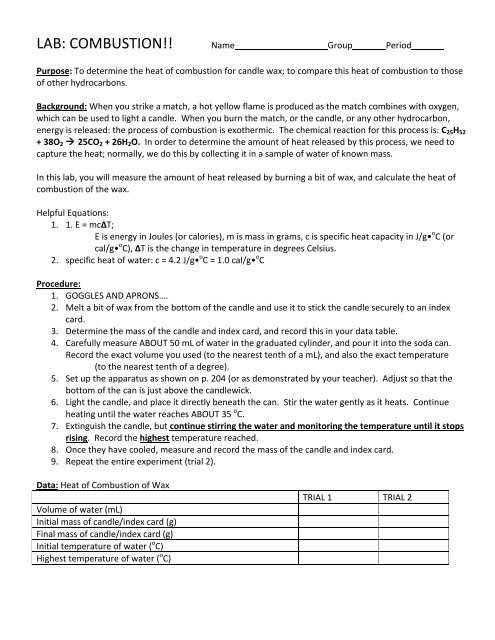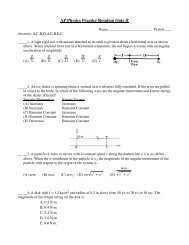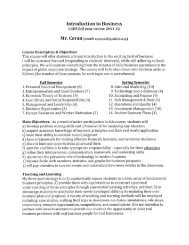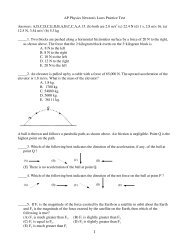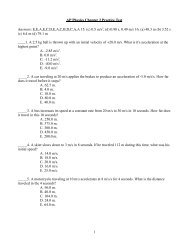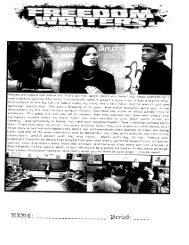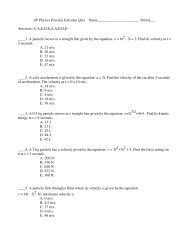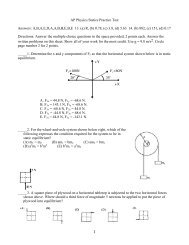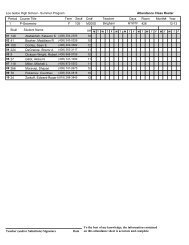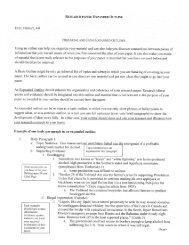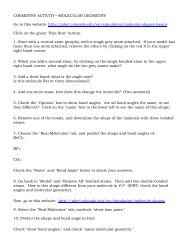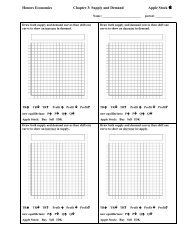Lab Heat of Combustion.pdf
Lab Heat of Combustion.pdf
Lab Heat of Combustion.pdf
Create successful ePaper yourself
Turn your PDF publications into a flip-book with our unique Google optimized e-Paper software.
LAB: COMBUSTION!! Name Group Period Purpose: To determine the heat <strong>of</strong> combustion for candle wax; to compare this heat <strong>of</strong> combustion to those <strong>of</strong> other hydrocarbons. Background: When you strike a match, a hot yellow flame is produced as the match combines with oxygen, which can be used to light a candle. When you burn the match, or the candle, or any other hydrocarbon, energy is released: the process <strong>of</strong> combustion is exothermic. The chemical reaction for this process is: C 25 H 52 + 38O 2 à 25CO 2 + 26H 2 O. In order to determine the amount <strong>of</strong> heat released by this process, we need to capture the heat; normally, we do this by collecting it in a sample <strong>of</strong> water <strong>of</strong> known mass. In this lab, you will measure the amount <strong>of</strong> heat released by burning a bit <strong>of</strong> wax, and calculate the heat <strong>of</strong> combustion <strong>of</strong> the wax. Helpful Equations: 1. 1. E = mcΔT; E is energy in Joules (or calories), m is mass in grams, c is specific heat capacity in J/g• o C (or cal/g• o C), ΔT is the change in temperature in degrees Celsius. 2. specific heat <strong>of</strong> water: c = 4.2 J/g• o C = 1.0 cal/g• o C Procedure: 1. GOGGLES AND APRONS…. 2. Melt a bit <strong>of</strong> wax from the bottom <strong>of</strong> the candle and use it to stick the candle securely to an index card. 3. Determine the mass <strong>of</strong> the candle and index card, and record this in your data table. 4. Carefully measure ABOUT 50 mL <strong>of</strong> water in the graduated cylinder, and pour it into the soda can. Record the exact volume you used (to the nearest tenth <strong>of</strong> a mL), and also the exact temperature (to the nearest tenth <strong>of</strong> a degree). 5. Set up the apparatus as shown on p. 204 (or as demonstrated by your teacher). Adjust so that the bottom <strong>of</strong> the can is just above the candlewick. 6. Light the candle, and place it directly beneath the can. Stir the water gently as it heats. Continue heating until the water reaches ABOUT 35 o C. 7. Extinguish the candle, but continue stirring the water and monitoring the temperature until it stops rising. Record the highest temperature reached. 8. Once they have cooled, measure and record the mass <strong>of</strong> the candle and index card. 9. Repeat the entire experiment (trial 2). Data: <strong>Heat</strong> <strong>of</strong> <strong>Combustion</strong> <strong>of</strong> Wax Volume <strong>of</strong> water (mL) Initial mass <strong>of</strong> candle/index card (g) Final mass <strong>of</strong> candle/index card (g) Initial temperature <strong>of</strong> water ( o C) Highest temperature <strong>of</strong> water ( o C) TRIAL 1 TRIAL 2
Prelab: 1. What is the purpose <strong>of</strong> this experiment? 2. What is the chemical equation for the burning <strong>of</strong> paraffin (wax)? 3. Define combustion: 4. Define exothermic: 5. What is the purpose <strong>of</strong> the card? 6. You will be using a soda can for a calorimeter, how will you support the can? 7. How are we measuring the heat released by the burning candle? 8. What is the specific heat <strong>of</strong> water or c water ? What does this number mean? 9. What is the formula (equation) for calculating the heat absorbed by the water? 10. If we had 100 grams <strong>of</strong> water in the can, and by heating the water with the candle raised the temperature 32°C, then how much heat (in Joules) was absorbed by the water? Use the formula from Question #9 and the value c water from question #8. 11. If the candle and card had a pre-‐burn mass <strong>of</strong> 15.27 g and a post-‐burn mass <strong>of</strong> 14.89 g how much paraffin (wax) was converted to products? 12. <strong>Heat</strong> <strong>of</strong> combustion is the amount <strong>of</strong> heat released per gram <strong>of</strong> burning substance. Using your answers from Questions #10 and Question #11, determine a heat <strong>of</strong> combustion for paraffin. (heat <strong>of</strong> combustion = heat released / grams burned)
Calculations: (Page 204-‐205): Show your work for each calculation, including units. 1. Calculate the mass <strong>of</strong> water heated. (Hint: the density <strong>of</strong> liquid water is 1.0 g/mL. Thus each milliliter <strong>of</strong> water has a mass <strong>of</strong> 1.0 g) Trial 1: Trial 2: 2. Calculate the total rise in temperature <strong>of</strong> the water. Trial 1: Trial 2: 3. Calculate how much thermal energy was used to heat the water sample. Use values from the two preceding steps to reason out he answer, as illustrated in the sample problem on p.204. Trial 1: Trial 2: 4. Calculate the total mass <strong>of</strong> paraffin wax burned. Trial 1: Trial 2: 5. Calculate the heat <strong>of</strong> combustion <strong>of</strong> paraffin, expressed… a. In units <strong>of</strong> joules per gram (J/g) <strong>of</strong> paraffin. Hint: Assume that all the energy released by the burning paraffin wax is absorbed by the water. Divide the total thermal energy by the mass <strong>of</strong> paraffin burned to get the answer. <strong>Heat</strong> <strong>of</strong> combustion = Thermal energy released Mass <strong>of</strong> paraffin burned Trial 1: Trial 2: b. In units <strong>of</strong> kJ/g. Trial 1: Trial 2:
Questions: Answer in complete sentences below. 1. In calculating the heats <strong>of</strong> combustion, you assumed that all thermal energy from the burning fuel went to heating the water. a. Is this a good assumption? Explain. b. What other laboratory conditions or assumptions might cause errors in your calculated values? 2. Do you think an experiment using a more refined calorimeter would give a higher or lower value than the one you determined in your calculations? Explain. 3. Assume some black soot formed on the bottom <strong>of</strong> your soda can during your experiment. Would this contribute to a high or low value for your heat <strong>of</strong> combustion? Explain. Conclusion: What did you do? What was the purpose <strong>of</strong> the experiment? What did you determine and learn from conducting this experiment? What errors did you encounter while conducting this experiment?


